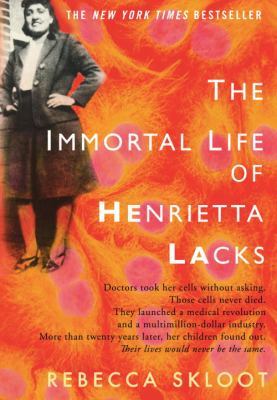Hundreds, if not thousands, of medical advances in the last half-century have been made possible by one woman, and most people, even in the medical field, have never heard of her. Today I’d like to introduce you to Henrietta Lacks, better known in the scientific world as HeLa.
In January 1951, Henrietta Lacks went to the doctor complaining of a “knot on my womb.” As a black woman, the only hospital nearby that would see her was Johns Hopkins Hospital twenty miles away from her home, so that’s where she had her husband drive her. After an exam and biopsy, she was diagnosed with an aggressive form of cervical cancer and returned a week later to start radiation treatments. Unfortunately, the treatments were unsuccessful and Mrs. Lacks died on October 4, 1951 at the age of only thirty-one.
Ms. Skloot points out that, “many doctors of [this] era…often used patients from the public wards for research, usually without their knowledge” – patients like Mrs. Lacks. During her first treatment and unbeknownst to Mrs. Lacks, the physician took two small samples of her cervical tissue, one from the tumor and one from healthy tissue. Scientists had been trying to grow human cells in the lab for years and hadn’t had any success. Mrs. Lacks’ cancer cells were different. They continued to live long past the age at which other cells had died and, because of their malignancy, they reproduced at a faster rate than normal cells. Even though they were cancerous, they were similar enough to healthy cells that they could be useful for researchers. “They produced proteins and communicated with one another like normal cells, they divided and generated energy, they expressed genes and regulated them, and they were susceptible to infections, which made them an optimal tool for synthesizing and studying any number of things in culture, including bacteria, hormones, proteins, and especially viruses.”
As was normal at the time, the cells were identified with the first two letters of the patient’s first and last name, in this case HeLa. HeLa “was a workhorse: it was hardy, it was inexpensive, and it was everywhere.” Scientists were able to use HeLa to “develop methods for freezing cells without harming or changing them.” They also led to the standardization of the field, important for scientists to be able to replicate the experiments and discoveries of others. HeLa was one of the cell types used to discover the correct number of chromosomes in human DNA. Perhaps the most stunning of HeLa’s major accomplishments, however, was the polio vaccine. HeLa’s ability to reproduce so quickly, and its susceptibility to the polio virus, made it possible for Dr. Salk to perform the necessary neutralization tests required to make sure the vaccine was safe before it could be used in children.
Ms. Skloot’s writing is thorough and engaging. She weaves an understanding of the “benevolent deception” of medical practice at the time with the specter of the ethical violations that horrify us now, including the Tuskegee syphilis experiments. She traces the history of informed consent and the ethics of medical research including the Nuremberg Code, developed after the atrocities Nazi doctors committed on Jews came to light. She delves into the flirtation with eugenics that some scientists of the time engaged in, and its possible effects on the medical care that the poor and minorities received. As she learns more about the Lacks family, she investigates the disturbing and inhumane treatment of the mentally ill (one of Mrs. Lacks’ daughters, Elsie, was committed to the Hospital for the Negro Insane of Maryland where she died at age 15). She raises a multitude of modern ethical concerns highlighted by the experiences of the Lacks family, including commercialization of human biological materials, ownership of human tissue once removed from the person, patents, profits, and proprietary information. It’s very thought-provoking.
The history and science in The Immortal Life of Henrietta Lacks are fascinating, but Ms. Skloot adds a deft human touch by making this a personal story about Henrietta Lacks’ family as well, her husband and the five children she left behind when she died. Deborah, Mrs. Lacks’ youngest daughter, was barely two when her mother passed away. She became the driving force behind the family’s cooperation with Ms. Skloot. At first, she was very cautious and wary about allowing Ms. Skloot permission to access family records, having been exploited by others in the past claiming to want to help them uncover the truth about their mother’s cells. It took months for Ms. Skloot to earn her trust, and even then it was in very small increments and often one-step-forward-and-two-steps-back. While some of her relatives wanted to sue Johns Hopkins – and various other medical establishments which had profited from using HeLa cells – Deborah was more circumspect about it.
“I know my life could be better and I wish it was,” she told me. “When people hear about my mother cells they always say, ‘Oh y’all could be rich! Y’all gotta sue John Hopkin, y’all gotta do this and that.’ But I don’t want that.” She laughed. “Truth be told, I can’t get mad at science, because it help people live, and I’d be a mess without it. I’m a walking drugstore! I can’t say nuthin bad about science, but I won’t lie, I would like some health insurance so I don’t got to pay all that money every month for drugs my mother cells probably helped make.”There is a very real human cost behind every medical discovery, every surgical advance, every ground-breaking miracle drug. The Immortal Life of Henrietta Lacks gives us a glimpse into one family’s compelling story.
The Immortal Life of Henrietta Lacks
by Rebecca Skloot
ISBN: 9781400052172
Buy it from Amazon here: (hardcover, audiobook, paperback, ebook)
Find it at a local independent bookseller.
Look it up on Goodreads.
Check it out at your local library (find the nearest one here).


No comments:
Post a Comment